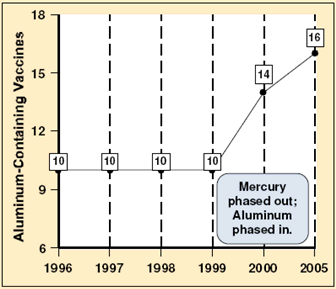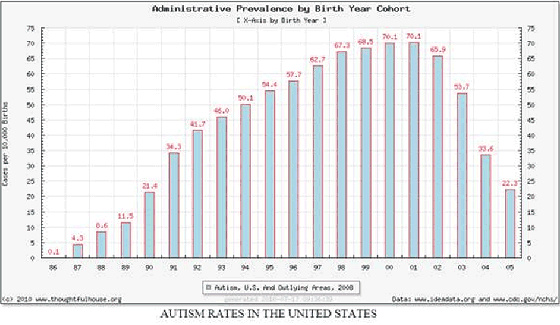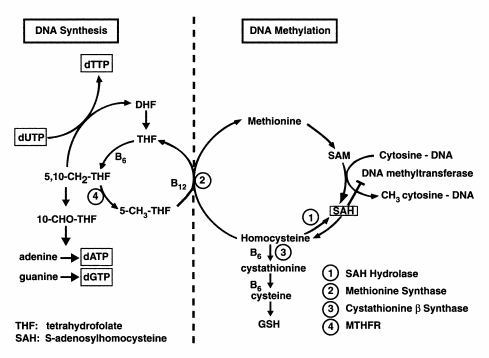Valley of the Sun Autism Network– a resource for parents of kids with autism who live in Phoenix, Arizona and surrounding areas. They provide information on topics of interest including doctors, co-op, meetings, forums, providers, therapists and ideas for living a healthy and toxic-free life.
Autism is a biomedical illness caused by an unfortunate combination of genetic susceptibility and exposure to more toxins than the system can handle, either before or after birth. The result is dysfunctional neural processing and significant social deficits.
Autism spectrum disorders, including Asperger’s syndrome and pervasive developmental delay, are complicated illnesses. They are all characterized by delayed development in some aspect of our human existence. Autism and Asperger’s syndrome characteristically involve repetitive behaviors that result in deficient interpersonal relationships.
The incidence of autism and autism-spectrum disorders has skyrocketed since the early 1980s, when large numbers of thimerosal-preserved vaccines came into common use, and when multiple vaccinations were given to children at about 15 months of age. That timing sparked a raging controversy, pitting parents against physicians against vaccine manufacturers against the government arguing whether the damage done to a generation of children is blamed on mercury’s use as a preservative.[1,2]
That controversy still persists, but in 1999 it was agreed that vaccines should be made thimerosal-free or low-thimerosal. By 2002 most vaccines no longer contained mercury.
Unfortunately some vaccines also contain an aluminum adjuvant, which is also neurotoxic, although less so than mercury. Neil Z. Miller of the Thinktwice Global Vaccine Institute points out that the number of vaccines with aluminum has increased:
 "The hepatitis B vaccine given at birth contains 250 mcg of aluminum - 20 times higher than safety levels ... Babies who have followed the CDC immunization schedule are injected with nearly 5000 mcg (5 mg) of aluminum by 18 months of age."[3]
"The hepatitis B vaccine given at birth contains 250 mcg of aluminum - 20 times higher than safety levels ... Babies who have followed the CDC immunization schedule are injected with nearly 5000 mcg (5 mg) of aluminum by 18 months of age."[3]
You will also find that MSG, a neurotoxin, is a component of some vaccines. The flu vaccine continues to be preserved with mercury, and is recommended by official governmental policy most strongly for the very young and the very old, precisely those least able to deal with the extra toxic load.
Some biological dentists will say that no child should be vaccinated until all the "adult" teeth have erupted. Before then, the theory goes, the immature immune system cannot handle vaccines well.
The statistics that used to tell us the rate of autism was 1 in 150 - have changed dramatically. In October 2009, two government studies raised the estimates of childhood autism from 1 in 150 to 1 in 91. In December 2009, the CDC officially pegged it at 1 in 110. Boys are four times more likely than girls to be diagnosed; 1 in 58. Studies suggest testosterone has an affinity for mercury. 2005 research has shown that testosterone significantly potentiates mercury toxicity, whereas estrogen is protective.[4]
IF NOT ALWAYS VACCINES, WHAT ELSE?
Some children who are autistic have not been vaccinated. And autism existed well before the 1980s when the vaccination schedule increased, and the amount of mercury delivered skyrocketed.
Many factors can influence the development of an autistic child,[1] including
- intra-uterine or pre-natal maternal dietary deficiencies
- immunizations, too many, too soon
- infections
- deficiencies in the intestinal tract and immune system
- food or chemical allergies
- heavy metal and other toxicities
There does not seem to be one single factor which causes autism.
It has been proposed, but not proven, that if the mother has an infection this can trigger either an inflammatory response in the fetus, or the development of antibodies to neural tissues, resulting in an autoimmune response in the fetal brain and body.
Amalgam fillings are the largest source of mercury in the body. There is considerable controversy about amalgam (or “silver”) fillings as well - they are about 50% mercury - but there seems to be no doubt that mercury levels in the body are directly correlated with the number of amalgam fillings.[5] A mother with amalgam fillings will download mercury to her child while breastfeeding. In 2008, Norway banned the used of mercury fillings; Germany, Sweden and Denmark severely restrict the use of them. Were the ADA to reverse its position that amalgams are safe, the potential liability claims would be spectacular.
Many parents like to remodel the house to accommodate a new baby. However, the process often introduces toxins in the environment. Carpet fibers and glues, for example, could be made with any of the 75,000 synthetic chemicals developed and released into the environment since World War II. Fewer than half have been tested for potential toxicity to human beings. Particle board furniture off gasses formaldehyde. Paint releases VOCs for up to a year. Phthalates – a chemical added to soften plastic - are still used in toys which children chew on. Relative to their weight and size, children ingest more food, drink more water and breathe more air than adults; their bodies are ill-equipped to handle such a firestorm of exposure. Childhood is a period of critical organ development and fast growth. The brain growth spurt lasts all the way through age two, and once disruption occurs in the nervous system, it cannot be repaired. A child’s natural defense mechanisms are not yet fully developed, especially during the first few months, and they are less able to break down certain toxins and excrete them. And some children have better genes than others when it comes to detoxing chemicals.
Much corn now is a genetically modified food, and corn products are found in everything from baby formula to talcum powder. In the late 1930s, scientists were able to splice pesticides and antibiotic resistant bacteria into the DNA of crops. Convenient for the farmer perhaps, but what happens when that pesticide or unnatural bacterial inhabits an infant’s gut? Most autistic children have intestinal malfunction, so we know something is damaging their guts. The rise in autism correlates with the rise in GMO foods. And high fructose corn syrup is generally processed in a way that allows mercury residues in the final product. Although 95 percent of our genes are identical, critical variations take place in that remaining 5 percent that differs from one person to another. Glutathione is a protein that is produced by the body and it acts as a natural detoxer. Levels are low in autistic children because protein production has been somehow disrupted and they are unable to excrete toxins as well as some other children.
Dr. Natasha Campbell-McBride, a British pediatrician, believes that the link between learning disabilities and the condition of our digestive system is the key to understanding autism. “We really started prescribing antibiotics for everything and anything in the ’70s and ’80s,” she says. “That’s when we started to get generations of people with compromised gut flora. Antibiotics wipe out the beneficial bacteria as well as the pathogenic bacteria… Between 95-100% of mothers of children with autism, hyperactivity, asthma, eczema and other problems, also have conditions that are related to abnormal gut flora. I hardly ever see healthy mothers.”[6]
These kinds of factors and more give rise to the “toxic assault” theory. Today’s children are burdened with toxins from conception. The bodies of virtually all pregnant women in America carry multiple chemicals. A 2011 study from the University of California at San Francisco found that 95 percent or more of the pregnant women tested positive for polychlorinated biphenyls (PCBs), organochlorine pesticides, perfluorinated compounds (PFCs), phenols, polybrominated diphenyl ethers (PBDEs), phthalates, polycyclic aromatic hydrocarbons (PAHs) and perchlorate (rocket fuel), and Bisphenol A (BPA), which makes plastic hard and clear and is found in epoxy resins that are used to line the inside of metal food and beverage cans. These are chemicals women are exposed to everday.[6a] Chemicals can cross the placenta and enter the fetus. Not surprisingly, Environmental Working Group and the CDC studied umbilical cord blood and found babies are loaded with chemicals - fire retardants, pesticides, and more.
Many parents will say their child turned autistic immediately after a vaccination, but it is probably too simple to blame just the vaccines. Many different elements combined to weaken today’s children such that one “well baby visit” can be the final straw.
WHAT DO WE KNOW ABOUT AUTISM?
Autistic children are easy to recognize. They are the children who do not play with other children. They have poor eye contact and little or no ability to speak. They sometimes have verbal understanding, but it is very difficult to get through to them. They have repetitive movements like hand flapping, staring at ceiling fans, and hitting themselves. They are sometimes thought to be deaf because they often do not respond when their names are called. They may communicate through grunts, or screams, or pulling at parents’ arm or clothes.
The DSM-IV (the American Psychiatric Association’s Diagnostic and Statistical Manual of Mental Disorders) recognizes the following as criteria for diagnosis of autism:
- The disease is defined by symptoms that appear before the age of three which reflect delayed or abnormal development in language, social skills and behavioral repertoire
- Impaired social interaction (at least 2 manifestations)
- Impaired communication
- Repetitive behaviors, activities, and interests
Children with autism have a heightened sensitivity to all sensory input. The parietal lobes, where sensory input is integrated, are out of balance; they are not properly connected to other parts of the brain like the temporal lobes, where language is processed. The autistic child’s “stimming”, or repetitive activities like rocking, humming, hitting themselves, may well be simply their way of creating “white noise” to shut out the excessive sensory input.
A few children are autistic from birth. These are the babies who do not cuddle, who do not look at the mother, who do not like to be touched. Most autistic children manifest their disability around the age of 15-18 months.
Autism seems to be a disease on the severe end of a spectrum of chronic diseases which includes Asperger’s disease, developmental disorders, Attention deficit (hyperactivity) disorder, childhood asthma, juvenile rheumatoid arthritis, and other auto-immune diseases. The incidence of these illnesses has also increased dramatically since the 1960s, most likely due to a combination of genetic susceptibility with ever-increasing pollution of our atmosphere, food, water and soil.[7]
HOW DO WE APPROACH AUTISM?
Are these children best served, as the allopathic community tells parents, by controlling their behavior with pharmaceuticals and just giving them a lot of love?
Of course, all children need love, autistic or not. But drugs add to the chemical burden and all drugs come with side effects. If the neural processing is defective, is there no way to help it develop correctly? If children are unable to detoxify heavy metals by themselves, is there no way to help them rid their bodies of these neurotoxic metals? If they have chronic diarrhea, or chronic constipation, is there no way, outside of pharmacology, to help them improve their quality of life?
If the answer were easy, there would not be such a proliferation of self-help parent groups, and there would be agreement among physicians treating this disorder. There does not appear to be a single “one size fits all” answer.
But there are answers - they just have to be discovered and individualized to the child.
Some of the answers lie in the area of virology and gastroenterology. It has been shown conclusively that some children who receive the measles virus in a vaccine are unable to eliminate the virus from their systems. Instead, the virus lives on in the intestinal tract, giving rise to lymphoid hyperplasia (swelling of the lymphatic glands in the GI tract) and chronic GI symptoms with which parents of autistic children are so familiar.[8,9,10,11]
Some of the answers lie in the area of biochemistry. Autistic children typically have significant difficulty with detoxification of viruses, organic pollutants, heavy metals, and often pharmaceutical medication. Many of these children have somewhat abnormal genes controlling the initial detoxification pathways, through methylation and sulfation and synthesis of glutathione. Glutathione[12] is produced by all mammals, and is found all over the body. It is a powerful antioxidant, and plays a key role in liver detoxification of all kinds of chemicals and viruses.
Some of the answers lie in the area of clinical metal toxicology. Mercury is one of the most toxic substances known to humankind. Lead comes right on its heels. Arsenic, cadmium, and aluminum are not far behind. Toxicity is the major cause of chronic illness in our 21st century world. One out of every 6 women in the United States today is mercury toxic, according to data from the NHANES study in 2002.[13] Infants are born with an average of over 200 toxic chemicals in their blood.[14] In order to remove toxicity, it is necessary to clean up both the intestinal tract and the liver, so that they can function as the toxic filters and excretors they are meant to be. Sometimes it is not possible to restore the intestinal tract to health unless we deal with the heavy metals first.
Treatment for heavy metal toxicity is accomplished through several means, including oral EDTA, various creams rubbed on the skin - both DMPS and EDTA, oral DMSA, oral penicillamine, and other agents. Many of these medications can also be given intravenously. Measurement of the heavy metal body burden is sometimes difficult, as autistic children have difficulty excreting these heavy metals.[15] They may require treatment for up to a year before the heavy metals start to be excreted in measurable quantities.
Once neural development is defective, is there any way to restore the normal pathways and normal function? Primitive reflexes appear to be retained in children with both autism and Asperger’s syndrome.[16] In fact, movement disturbances in children later diagnosed as autistic seem to appear early in life, as early as 4-6 months, and are at least potentially diagnostic.[17] Neurofeedback has been helpful in the treatment of some autistic children.[18,19,20]
From the point of view of neurodevelopment, the brain appears to be in a hyperexcitable state, perceiving many sensations in an accelerated fashion, while being deficient in auditory and language processing. Often the parietal lobes, where sensory input function is located, perceive the sensory input in a distorted fashion, resulting by necessity in a distortion of reality. This distortion no doubt prompts some of the behaviors associated with autism - the stimming and the stereotypic movements. Many children diagnosed with autism suffer from environmental overload. How we see the world is determined by how our brain interprets information through our five senses. Each sensory channel can be affected in different ways, hyperactive, hypoactive, or disrupted by “white noise” interference from within the system.
Neurotherapy can assist in stimulating those areas of decreased function, calming those areas of increased function, and modifying some of the distorted information pathways in the brain, allowing the brain to receive distortion-free sensory input. The brain then has the potential to re-set itself, re-establishing more normal neural connections.
Missed stages of neurodevelopment need to be corrected, through a series of training exercises which are done at home.
PERSONALIZING THE TREATMENT
At the Arizona Center for Advanced Medicine, we make every effort to determine the metabolic pathways that are dysfunctional. This is done best through genetic testing, but can be accomplished simply by adding supplements on the “trial and error” principle - if they get better we keep the supplement, if they get worse we eliminate it.
We modify their diets, to ensure that they are not sensitive to any of the foods they are eating. We prefer to do allergy testing first, because it is much easier to eliminate a favorite food if it becomes clear that the food is causing behavioral or physical reactions. Since so many children are sensitive to the break-down products of gluten and casein (more than 50%), even if testing is negative, this is the first step of many in dietary modification.
We may treat children for heavy metal toxicity. For those whose initial provocation tests are negative, we may use other means to determine whether mercury toxicity may be a significant part of their disease.
There are, unfortunately, no easy fixes. But we will not give up. We will walk the journey with you, and explore new avenues as we come across them. We will investigate new things that you find, and together we will determine the best course of action for your child.


